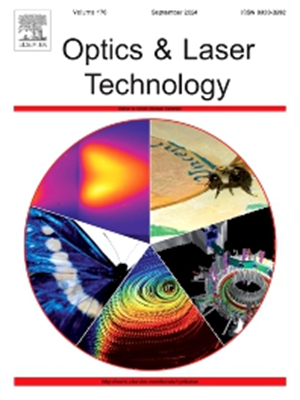MSFA-Net: Multi-scale feature aggregation and attention-enhanced U-Net for microscopic hyperspectral pathology images segmentation
IF 5
2区 物理与天体物理
Q1 OPTICS
引用次数: 0
Abstract
Pathological diagnosis is regarded as the gold standard for early gastric cancer detection. Automatic segmentation efficiently delineates lesion areas, which are essential for identifying and diagnosing these lesions. Current segmentation methods that rely on grayscale or RGB images are hindered by limited information, whereas advancements in microscopic hyperspectral imaging technology offer a novel perspective for early gastric cancer diagnosis. This technology provides rich spatial and spectral information that effectively reflects the chemical composition and physical state of tissues, thereby enhancing the identification of cancerous regions. U-Net has marked a significant advancement in segmentation networks and has demonstrated promising results in hyperspectral pathology images segmentation tasks. However, the substantial semantic gap between its encoder and decoder presents challenges in addressing complex lesion areas. To address this problem, a multi-scale feature fusion and attention-enhanced U-Net (MSFA-Net) is proposed which optimized for reduce semantic gaps, and applied to the segmentation of precancerous lesions in gastric cancer using microscopic hyperspectral pathology images. The Cross-Stage Feature Fusion (CSFF) module is designed to accurately merge encoder-level features, alongside Multi-Scale Integrated Convolution (MSIConv) extracts multi-scale features, effectively bridging the semantic gap between the encoder and decoder. Additionally, the Adaptive-weighted Attention (AWA) module is designed to optimize the fusion of encoder and decoder features, further enhancing the recovery of image details. Experimental results demonstrate that the model performs well on both Intestinal Metaplasia (IM) and Gastric Intraepithelial Neoplasia (GIN) stages of precancerous gastric cancer.
MSFA-Net:用于显微高光谱病理图像分割的多尺度特征聚合和注意力增强的U-Net
病理诊断被认为是胃癌早期发现的金标准。自动分割能有效地划分病灶区域,对病灶的识别和诊断至关重要。目前依赖灰度或RGB图像的分割方法受到信息有限的阻碍,而显微高光谱成像技术的进步为早期胃癌诊断提供了新的视角。该技术提供了丰富的空间和光谱信息,有效地反映了组织的化学成分和物理状态,从而增强了癌变区域的识别。U-Net标志着分割网络的重大进步,并在高光谱病理图像分割任务中显示出有希望的结果。然而,其编码器和解码器之间的实质性语义差距提出了解决复杂病变区域的挑战。为了解决这一问题,提出了一种多尺度特征融合和注意力增强的U-Net (MSFA-Net)算法,该算法对减少语义间隙进行了优化,并应用于显微高光谱病理图像对胃癌癌前病变的分割。跨阶段特征融合(CSFF)模块用于准确融合编码器级特征,多尺度集成卷积(MSIConv)提取多尺度特征,有效弥合编码器和解码器之间的语义差距。此外,设计了自适应加权注意(AWA)模块,优化了编码器和解码器特征的融合,进一步增强了图像细节的恢复。实验结果表明,该模型对胃癌前病变的肠上皮化生(IM)和胃上皮内瘤变(GIN)均有良好的治疗效果。
本文章由计算机程序翻译,如有差异,请以英文原文为准。
求助全文
约1分钟内获得全文
求助全文
来源期刊
CiteScore
8.50
自引率
10.00%
发文量
1060
审稿时长
3.4 months
期刊介绍:
Optics & Laser Technology aims to provide a vehicle for the publication of a broad range of high quality research and review papers in those fields of scientific and engineering research appertaining to the development and application of the technology of optics and lasers. Papers describing original work in these areas are submitted to rigorous refereeing prior to acceptance for publication.
The scope of Optics & Laser Technology encompasses, but is not restricted to, the following areas:
•development in all types of lasers
•developments in optoelectronic devices and photonics
•developments in new photonics and optical concepts
•developments in conventional optics, optical instruments and components
•techniques of optical metrology, including interferometry and optical fibre sensors
•LIDAR and other non-contact optical measurement techniques, including optical methods in heat and fluid flow
•applications of lasers to materials processing, optical NDT display (including holography) and optical communication
•research and development in the field of laser safety including studies of hazards resulting from the applications of lasers (laser safety, hazards of laser fume)
•developments in optical computing and optical information processing
•developments in new optical materials
•developments in new optical characterization methods and techniques
•developments in quantum optics
•developments in light assisted micro and nanofabrication methods and techniques
•developments in nanophotonics and biophotonics
•developments in imaging processing and systems

 求助内容:
求助内容: 应助结果提醒方式:
应助结果提醒方式:


